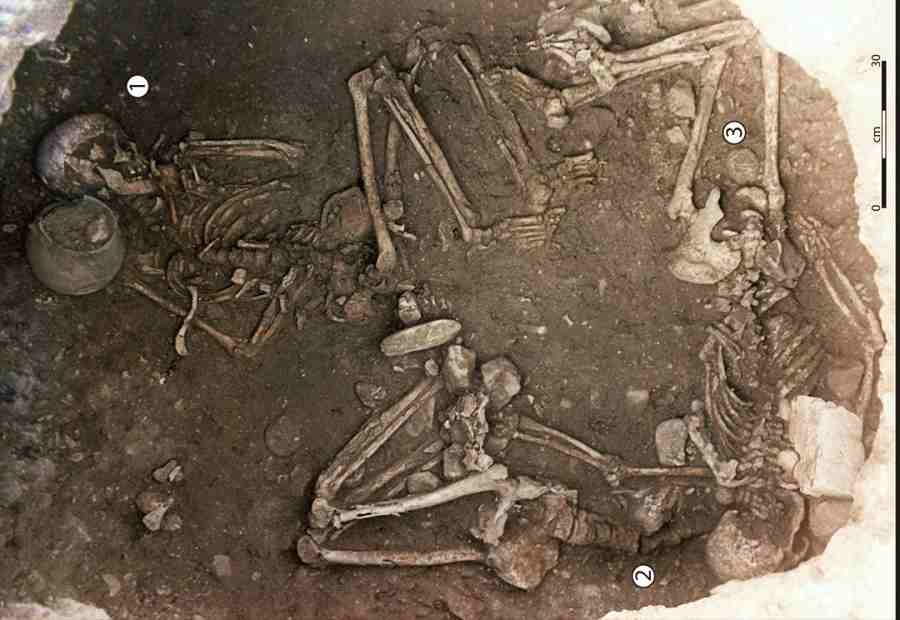![]() Researchers think that the central skeleton in the grave (marked 1) was an older woman who was buried after dying of natural causes, and that the two other skeletons (marked 2 and 3) were younger sacrificial victims bound “incaprettamento.” (Image credit: Ludes et al., Sci. Adv. 10, eadl3374 (2024))
Researchers think that the central skeleton in the grave (marked 1) was an older woman who was buried after dying of natural causes, and that the two other skeletons (marked 2 and 3) were younger sacrificial victims bound “incaprettamento.” (Image credit: Ludes et al., Sci. Adv. 10, eadl3374 (2024))
Tue 16 April 2024:
STUDY UNEARTHS PRACTICE OF WOMEN SACRIFICES ACROSS EUROPE DURING STONE AGE
Archaeologists identified a pattern of ritual killing during the Neolithic Age (or Stone Age) after analyzing skeletons of women buried in a tomb in France’s Rhone Valley. The skeletons were discovered with their necks tied to their legs behind their back, indicating that they had strangled themselves.
According to Live Science, the practice, known as incaprettamento, was widespread in Europe more than 2,000 years ago. The study, published on April 10 in Science Advances, found more than a dozen such killings.

The skeletons were found with their necks tied to their legs behind their back.
Archaeologists discovered traces of old Stone Age rites. The study of bones found in a tomb in France’s Rhone Valley reveals evidence of ritualistic homicides dating back more than 2,000 years. These findings, published in Science Advances on April 10, provide insight into our forefathers’ activities.
The tomb, located in Saint-Paul-Trois-Chateaux, Avignon, southern France, was discovered more than two decades ago. The tomb, which resembled a grain silo, contained the remains of three women who were interred some 5,500 years ago.
What is incaprettamento?
What distinguishes this find is the women’s sad fate. According to analysis, they were buried alive, demonstrating the traditions of the time. The skeletons were discovered with their necks connected to their legs behind their backs, a kind of self-strangulation known as incaprettamento.
Eric Crubrezy, a biological anthropologist at Paul Sabatier University, hypothesizes a link between these events and agriculture. “You have the alignment, you have the silo, you have the broken stones – so it seems that it was a rite related to agriculture,” he went on to say. Similar graves around Europe, dating from 5,400 to 3,500 BC, indicate a widespread practice.

The tomb containing the three skeletons was built in the style of a silo, or pit for storing grain, within a small wooden structure and surrounded by a trench. (Image credit: Ludes et al., Sci. Adv. 10, eadl3374 (2024))
According to Crubrezy’s team, incaprettamento most likely began as a sacrificial tradition in the Mesolithic period before evolving into human sacrifices related to agriculture in the Neolithic. Penny Bickle, an archaeologist at the University of York, supports this theory, citing a link between fertility rituals and human sacrifice.

This research sheds light on our ancient forefathers’ religious and cultural behaviors. While disconcerting to us today, it demonstrates the complexities of early cultures and the critical role rituals had in their lives.
SOURCE: INDEPENDENT PRESS AND NEWS AGENCIES
______________________________________________________________
FOLLOW INDEPENDENT PRESS:
WhatsApp CHANNEL
https://whatsapp.com/channel/0029VaAtNxX8fewmiFmN7N22
![]()
TWITTER (CLICK HERE)
https://twitter.com/IpIndependent
FACEBOOK (CLICK HERE)
https://web.facebook.com/ipindependent
YOUTUBE (CLICK HERE)
https://www.youtube.com/@ipindependent
Think your friends would be interested? Share this story!





